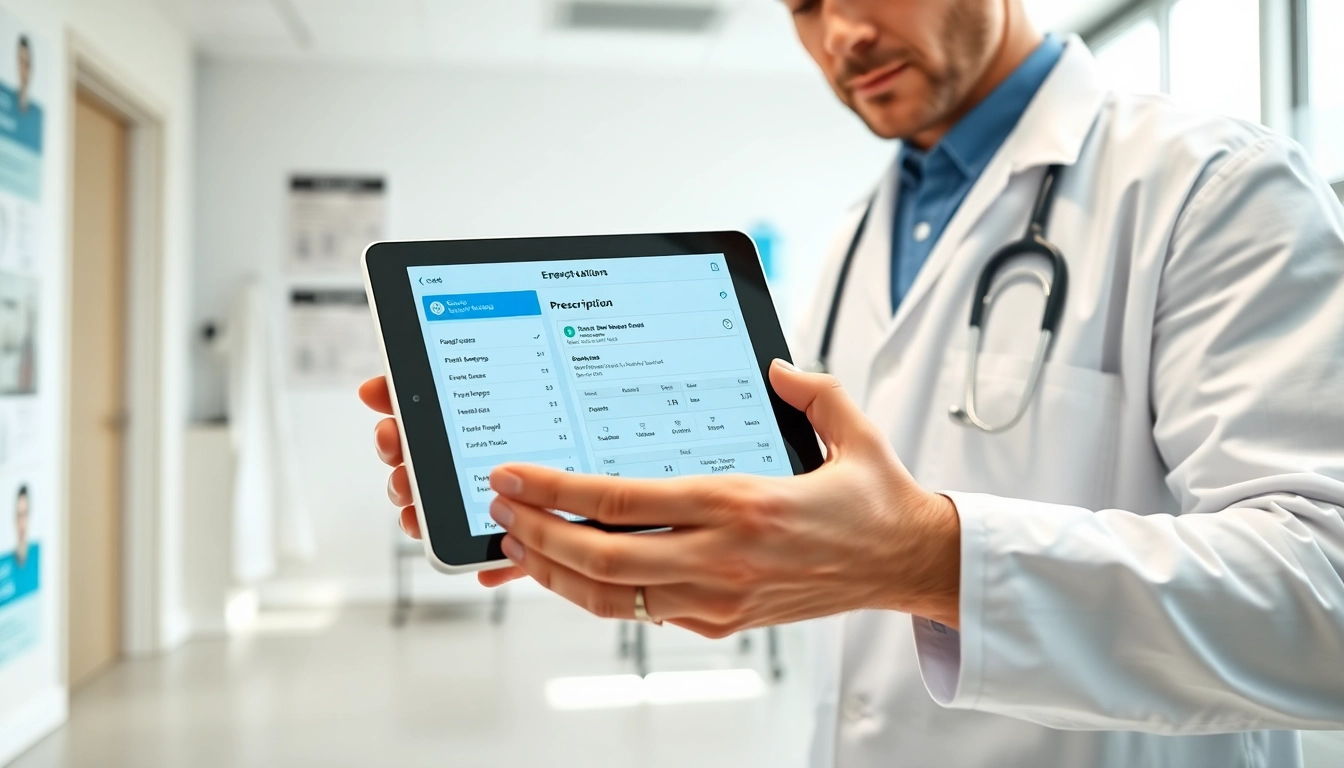Understanding Eprescribing Software for Doctors
In the evolving landscape of healthcare technology, electronic prescribing, commonly known as e-prescribing, has emerged as a critical tool for enhancing the efficiency and accuracy of the prescription process. With an increasing emphasis on patient safety, data management, and integrated healthcare solutions, utilizing eprescribing software for doctors offers various advantages that are difficult to overlook.
What is Eprescribing Software?
Eprescribing software is a digital platform that allows healthcare providers to create, send, and manage prescriptions electronically. Unlike traditional paper prescriptions, this technology enables quick transmission of prescriptions directly from the doctor’s office to the pharmacy. Most systems provide a user-friendly interface that integrates with existing electronic health record (EHR) systems, improving workflow and reducing the potential for errors associated with handwriting and transcription.
Benefits of Eprescribing Software for Doctors
The adoption of e-prescribing software offers several benefits that can significantly improve patient care and streamline operations:
- Increased Accuracy: Eprescribing reduces the likelihood of errors due to illegible handwriting, ensuring that patients receive the correct medications.
- Enhanced Efficiency: Prescriptions can be sent instantly to pharmacies, reducing wait times for patients and improving the prescribing process workflow.
- Medication Management: Many e-prescribing solutions allow doctors to access patients’ medication histories, enabling better decision-making regarding prescriptions.
- Cost Savings: By streamlining the prescribing process, e-prescribing can decrease administrative costs related to processing paper prescriptions.
- Compliance and Regulation: Eprescribing software often includes built-in checks that ensure prescriptions are compliant with state and federal regulations, particularly beneficial in the context of controlled substances.
Common Features of Eprescribing Solutions
While various e-prescribing solutions may differ in functionality, several common features are found across most platforms:
- Prescription Transmission: The ability to send prescriptions electronically to pharmacies.
- Medication History Access: Integration with pharmacy and patient records to allow doctors to review past prescriptions.
- Drug Interaction Checks: Automated alerts for potential drug interactions or allergies based on patient data.
- Refill Management: Easy processing of prescription refills without requiring patient visits.
- Reporting and Analytics: Tools for tracking prescribing habits, managing controlled substance prescriptions, and reporting to regulatory bodies.
Choosing the Right Eprescribing Software for Doctors
Key Considerations for Selection
Choosing the right e-prescribing software can dramatically influence a practice’s operational effectiveness. Here are some essential factors to consider:
- User Experience: The interface should be intuitive for both providers and their staff, minimizing the learning curve associated with new software.
- Integration Capability: The software should seamlessly integrate with the EHR system and other tools used within the practice to ensure a cohesive workflow.
- Support and Training: Vendors should offer comprehensive training and customer support to address any issues that arise post-implementation.
- Compliance Features: Ensure that the software complies with current healthcare laws and regulations, especially for controlled substances.
- Scalability: Consider whether the software can accommodate the growth of your practice, whether in terms of features or user capacity.
Pricing and Budgeting for Software
The cost of e-prescribing software can vary widely based on features, licensing models, and vendor offerings. Based on your practice size and needs, explore the following pricing models:
- Subscription Model: Many solutions operate on a monthly or yearly subscription basis, often linked to the number of users.
- One-time Purchase: Some systems can be purchased outright, though they may require additional costs for updates and maintenance.
- Transaction Fees: Often, there are fees associated with each electronic transaction, particularly when sending prescriptions or conducting identity verification.
Begin by outlining your budget, considering not just the software costs but potential savings from improved efficiency and reduced error rates.
Integration with Existing Systems
For maximum efficiency, e-prescribing software should integrate effectively with other technologies used in the healthcare setting:
- Electronic Health Records (EHR): Ensure that the e-prescribing solution can communicate smoothly with your EHR to maintain patient data accuracy.
- Billing Systems: Integration with billing solutions can simplify payment processing and enhance revenue cycle management.
- Pharmacy Systems: Check for connections with local pharmacies to streamline prescription fulfillment.
Implementing Eprescribing Software for Doctors
Preparation Steps for Successful Implementation
Implementing e-prescribing software requires careful planning and execution. Here are essential steps to ensure a smooth transition:
- Assess Current Workflow: Review existing prescription processes to identify areas that will benefit from e-prescribing.
- Engage Stakeholders: Involve physicians, staff, and IT personnel in the selection and planning process to gather input and ensure buy-in.
- Plan for Data Migration: Ensure a strategy for transferring and syncing existing patient data with the new system.
- Trial Runs: Conduct pilot testing before a full rollout to recover from any unforeseen technical problems or user resistance.
Employee Training and Support
The success of new software heavily relies on the training and support provided to employees. Consider the following:
- Comprehensive Training Programs: Supplement vendor training with internal training sessions to ensure all users are competent.
- Ongoing Support: Designate a team member to act as the point person for any questions or technical problems during the initial rollout period.
- Feedback Mechanisms: Implement channels where users can provide feedback on their experiences to help enhance the software use and identify training needs.
Common Challenges During Implementation
Anticipating challenges can pave the way for a smoother implementation process:
- Resistance to Change: Some staff may be resistant to new technology; address this through effective change management strategies.
- Technical Difficulties: Hardware or software incompatibilities can arise; plan for IT support during the transition.
- Compliance Issues: Without a proper understanding of regulatory requirements, firms can inadvertently encounter compliance pitfalls during implementation.
Maximizing the Use of Eprescribing Software for Doctors
Best Practices for Daily Use
To fully leverage the capabilities of e-prescribing solutions in daily practice, consider the following best practices:
- Regular Update Reviews: Stay informed about updates to the software and any new features that could improve functionality.
- Use Alerts Effectively: Utilize built-in alerts for drug interactions and allergies to enhance patient safety.
- Continuous Monitoring: Keep track of prescription patterns to identify outliers or potential compliance issues.
Keeping Up with Software Updates and Features
The technology landscape is always evolving; thus, keeping up with software updates is crucial. Ensure to:
- Schedule Regular Training: Provide updated training sessions for all users to familiarize them with new features.
- Communicate Changes: Keep all stakeholders informed about software changes and updates to maintain usability.
- Request Feedback: Constantly solicit staff feedback regarding new features to gauge effectiveness and facilitate adjustments.
Utilizing Data for Patient Management
Data analytics can considerably enhance the utility of e-prescribing software:
- Patient Data Monitoring: Track patient compliance and medication adherence through the software.
- Quality Improvement Initiatives: Use data to identify trends, evaluate treatment effectiveness, and inform patient care strategies.
- Reporting: Utilize built-in reporting features to comply with regulatory expectations and assess practice performance.
Future Trends in Eprescribing Software for Doctors
Innovative Features on the Horizon
As the healthcare landscape shifts, incorporating the latest technology is essential. Future trends may include:
- Enhanced Artificial Intelligence: AI will play a role in streamlining prescribing processes and providing personalized medication management based on patient data.
- Mobile Application Development: Future software will likely include apps for mobile access and patient engagement, allowing for even greater convenience.
- Blockchain for Security: Improved security and data integrity through blockchain technology could revolutionize how prescriptions are handled.
The Role of Telemedicine in Eprescribing
The intersection of telemedicine and e-prescribing presents excellent opportunities for enhanced patient care:
- Remote Consultations: E-prescribing facilitates prescriptions in telehealth settings, allowing doctors to prescribe medications during virtual visits.
- Improved Access: E-prescribing can enable remote patients to easily obtain medications, improving healthcare access.
- Seamless Records Management: Integration of telemedicine consults with e-prescribing keeps patient records accurate and up-to-date.
Regulatory Changes Affecting Eprescribing
The landscape of e-prescribing is subject to ongoing regulatory changes. Awareness of these is crucial for compliance:
- Controlled Substances Regulations: Be aware of evolving rules and guidelines for prescribing controlled substances electronically.
- Increased Security Measures: Updated regulations often require enhanced security for patient data and prescription records.
- Reporting Requirements: Ensure that any e-prescribing software meets mandatory reporting requirements to regulatory bodies.



